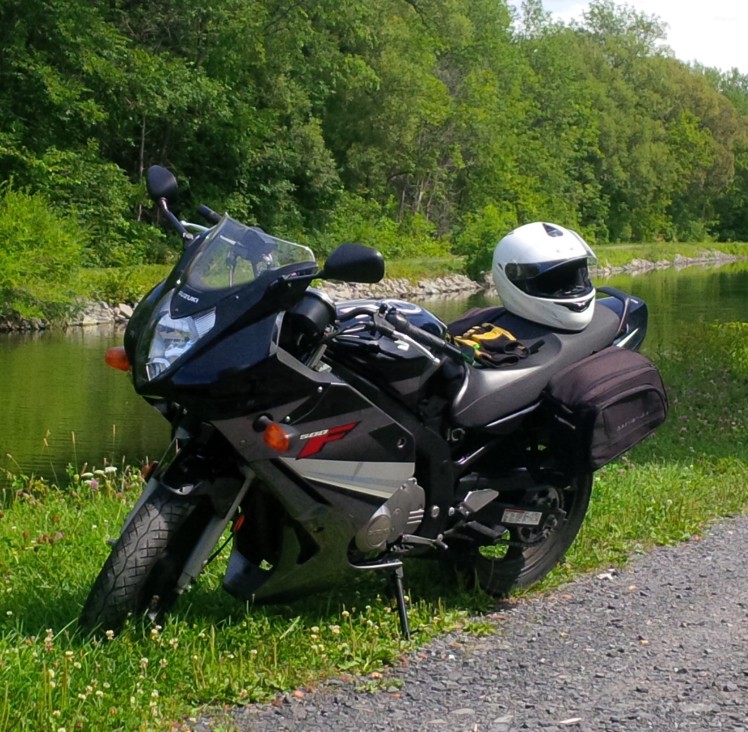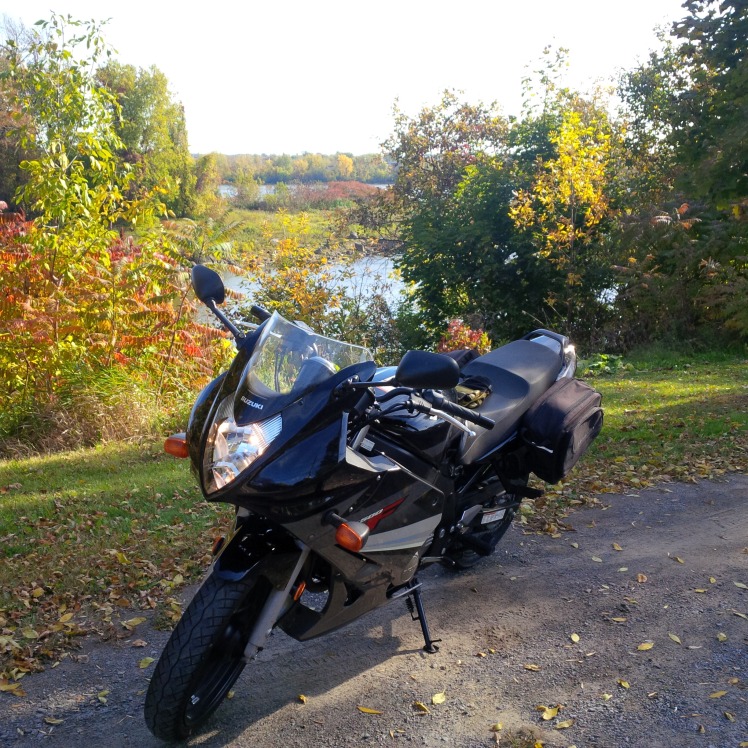
The Suzuki GS500F was my first bike. I don’t have it anymore, but I still think about it all the time. It’s a wonderful, simple machine. Released in 1989, and upgraded with a fairing in 2004, the Suzuki GS500 had a long, successful life in the motorcycle market. Mine was a 2009 model, the last year of production, and was built in Spain. I wish Suzuki was still making it, perhaps with a few modern upgrades like fuel injection, for example.
I bought mine at a dealership in Coquitlam, British Columbia, and it served me well until I traded it for a cruiser in Laval, Quebec, in 2016.
The GS500 has a parallel twin cylinder set-up (487 cc), 4-stroke, dual overhead cams, two valves per cylinder, is carburated, pushes out just under 50 horsepower, and is very agile due to slightly narrower rear tires (130s). One of the best things about the bike is that it comes with a centre stand as well as a side stand. This makes maintenance very easy. The riding position is generally upright, with an easy reach to the raised handlebar. Its 20-litre gas tank provides a range well in excess of 325 kilometres.
When my job took me from BC to Ontario, my wife suggested that instead of shipping it, I should ride the GS to Toronto while she drove our Toyota Corolla. For people who enjoy exploring as much as we do, it was one of our best decisions. We opted for the U.S. Route, following Interstate 90 (Washington-Idaho-Montana-Wyoming-South Dakota-Minnesota-Wisconsin-Illinois-through Michigan to Detroit and into Ontario). It was a memorable trip, with stops at historical sites like the Little Big Horn, site of Custer’s Last Stand, and at Mount Rushmore in the Black Hills of South Dakota. The bike handled well on the highway. One magazine reviewer once called the GS “the most economical sport-touring mount money can buy.” Wind protection on the faired model is very good. Unlike a Harley Davidson, the bike is relatively light, so I found I had to lean it over a bit when we encountered strong southerly winds in the prairies. In wind-from-the-side situations at interstate speeds, the body panels can act a bit like a sail. I’m sure this is the case with most other bikes with solid fairings. In all other situations, however, the windshield and fairing made it easy to cover long distances. It’s a comfortable motorcycle.

In terms of engine performance, at 100 kilometres per hour the engine is turning at a comfortable 5,000 RPM and rises to 6,000 at 120 kph; but with the redline fixed at 11,000 RPM, freeway speeds are handled with ease.
When you ride your bike for hundreds of kilometres a day, you really bond with your vehicle. You get to know each sound the motorcycle makes in any situation and your muscle memory grows daily, making riding more instinctive.
Once we settled in Toronto and I was working downtown, I would often take long detours on tree-lined Rosedale Valley Road and the Don Valley Parkway just to make my rides last longer. It was a joyous commuting experience.
I was still riding the GS when we later moved to Montreal. I enjoyed exploring the city and surroundings every chance I could. Quebec has some beautiful country roads. My trips to Saint-Jean-sur-Richelieu, Île Bizard and the Laurentians were special.
The day eventually came when I decide to act on my desire to own a cruiser with a little more grunt. I was also ready to try a different riding style. But this led me to a difficult choice at the time because I couldn’t afford to own two bikes. If I could have kept the GS, I would have done so gladly. As I turned in the GS to the dealer for the ownership swap, I felt like a parent abandoning a child.
The GS is a solid machine known for its reliability. I put more than 20,000 kilometres on the odometer and experienced only minor issues during my years of ownership: a starter clutch failure and one chain and sprocket replacement. That’s it.
Like so many new riders, I dropped the motorbike, too. The first time it happened was on the second day of ownership, while trying to park on some gravel, not extending the kickstand all the way. The fall resulted in some cracks to the fairing on one side. The cracks were easily covered with black electrical tape and remained that way the entire time I owned it. The little flaws became part of the character of the bike.
The GS is wonderful on winding roads, quiet agile and punchy. The power is perfect for me. Not too big, nor too small.
The bike can also carry a lot of cargo. A metal rail runs under the long seat and it’s perfect for bungee chord attachment points. The long seat is comfortable for both rider and pillion.
I will always have room in my heart for that bike.
—————————-
If you would like to know more about the GS500 you can take a look at these links from other sources:
Text:
http://www.motorcycle-usa.com/2010/05/article/my-new-suzuki-gs500f-fan-report/
Video:
An Aussie tries the GS and comments:
I enjoy your writing style Renato. Looking forward to red you more!
LikeLike
Thank you! I really appreciate it. I hope to find enough time to write regularly, learn and share more info with motorcyclists in the process. Cheers!
LikeLike